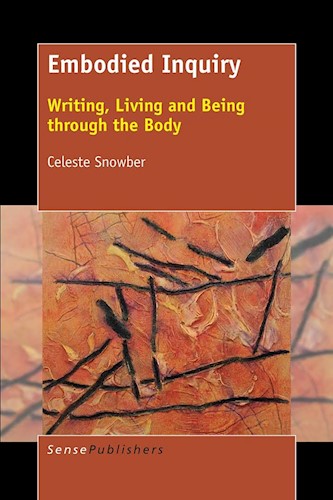Embodied Inquiry: Writing, Living and Being through the Body
Celeste Snowber
Sense Publishers 2016

Snowber, a long-time innovator and eloquent proponent of embodied enquiry, here offers a renewed call for recognizing the body as “a place of learning, understanding and perceiving”. Addressed not just to artists, but to anyone seeking to enrich and inform personal and professional life (“scientist…lawyer or educator…administrator or physician”) Snowber encourages readers who may be seeking to try new practices, renew neglected ones, or extend those already in place. The argument that the body has been too long separated from the whole being…”colonized, gendered, politicized, medicalized, and consumerized”... is not new, of course; but speaking from her identity as dancer, writer, poet, and educator, Snowber has a strong, particular voice in inviting readers to exploration. Developing or renewing an understanding of the individual body, how it rests/belongs in place, and relationships to others is a path to connecting with what Snowber identifies as the body’s knowledge and wisdom. Her invitation, then, is nothing less than to explore possibilities of how “our senses and bodily ways of perceiving and understanding can inform” life.
Snowber speaks, as she says, from “decades of teaching, writing and researching particularly in the area of bringing embodied ways of inquiry to arts education”; and as a long-time advocate of the inclusion in curriculum theory. While the techniques and methods described herein are identified as embodied inquiry; and while she does ally with the phenomenological, autobiographical, poetic inquiry, artography, arts-informed and similar research methods, Snowber stresses that she is herein reaching for “more of a way of being in the world”, a way of contributing to and enriching all the methodologies of research and practice, all forms of inquiry. This volume, says Snowber, is designed as “a companion piece to the vast scholarly work done on embodied ways of knowing and inquiry”.
Within, then: ways of letting the body “out”, through reflective solitude, awareness of physicality and experience of the sensuous; a practice of “writing from the body”; of listening to the whole; and looking for the understanding of where the body fits into the world and the environment—“an understanding of place, and by extension, belonging”. Snowber is completely generous sharing her own experiences, whether joys or sorrows; and her own practices such as “Walking into writing”: “The practice of walking a half hour a day, followed by writing in my journal for 20 minutes afterward, has become my go-to…”, a way of becoming wide-awake to the world. Throughout, there is acknowledgment throughout that this is above all an individual exploration—that readers can and will find their own ways into the material.
In essence, then, a personal and poetic invitation for individual exploration of the body’s essential wisdom; and a welcome reminder and encouragement: “All of the practices in embodied ways of inquiry are about finding the ecstatic in the daily.”
-Jane Alexandre